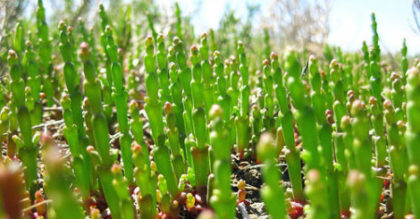
 )
)We’re on our final week discussing the English translation of Stefano Mancuso’s The Revolutionary Genius of Plants, a colorful and wide-ranging survey of recent developments in our understanding of plant biology. Mancuso is particularly interested in what sets plants apart from animals, reasoning that we can learn the most from our biggest differences. Two weeks ago we focused on the decentralized nature of plants; last week we looked at how plants have to solve problems while staying in one place. In the final chapters that we’ll look at this week, Mancuso tries to apply plant principles like these to solving human problems.
Chapter 7 takes up the question of feeding future humans. Mars colony aspirations aside, essentially all 7.7 billion of us have to stay put here on Earth; we can’t just wander somewhere else to find more food to eat. One of the challenges of expanding agriculture is salt; salt in the soil and salt in the water can inhibit plant growth. Mancuso has two ideas to meet this challenge. One is to take advantage of plants that already grow better than most in salty conditions. We can adapt the edible ones as crops, and perhaps also modify other crops to be more salt-tolerant. His other idea, developed with several colleagues, is floating hydroponic farms. They have a modular design inspired by the modular, decentralized nature of plants. They use solar energy to distill freshwater from salty seawater, making it possible to grow unadapted, salt-sensitive crops using water from the ocean. All of this plant-inspired agriculture comes together in the Jellyfish Barge–proving we still haven’t completely escaped our animal-centric perspective.
Mancuso notes that the Jellyfish Barge hasn’t yet found commercial engagement, but that’s fine because he has plenty of other ideas about how to apply plant principles. Chapter 8 takes decentralization and modularity to robotics. Apparently he is in the early stages of developing plant-inspired robots (aka “plantoids,” a play on android) for space exploration. Instead of the solitary rover approach we currently use in our Mars missions, he envisions thousands of small plantoids with suites of sensors like a root network and leaf-like solar panels for power. Instead of covering ground with a mobile rover, we would sow a host of little robots that would stay in place and contribute what they learn from their little corner of Mars to an overall picture. His is certainly an intriguing vision; I have no idea if it is practical to build such plantoids and what their collective mass would be compared to a rover, since mass is a significant consideration in the cost of a space mission. But I appreciate the creativity and imagination and hope it will lead somewhere fruitful.
And while we are in space, chapter 9 discusses taking plants themselves and not just their robotic equivalents into the final frontier. Botany may not seem like an obvious entry point into the space program (although it worked for Mark Watney), but Mancuso’s plant studies have gotten him rides on the exclusive zero-gravity flights used by space programs to train astronauts and to conduct research. Mancuso designed experiments to test how plants respond to changes in gravity and lack of gravity, conditions plants would otherwise rarely experience. Remarkably, they do react, and rather quickly according to Mancuso’s data, apparently a testament to the vigilance regarding their surroundings.
Obviously most of us will never be munching mangoes on Mars, so what do we take away from all of this botany? Maybe you might see some way to apply his plant principles to your area of study or your daily life, or maybe thinking like a plant seems like a bit too much of a stretch for you. Even if those specific ideas don’t seem relevant, I think there is something to be said for stretching our minds by studying aspects of creation that are beyond our personal experience. In doing so, we might learn to appreciate the Creator in a way we wouldn’t have otherwise.
FYI: This is the last week to get the early bird discount for the upcoming BioLogos conference in Baltimore. I hope to see you there!
Andy has worn many hats in his life. He knows this is a dreadfully clichéd notion, but since it is also literally true he uses it anyway. Among his current metaphorical hats: husband of one wife, father of two teenagers, reader of science fiction and science fact, enthusiast of contemporary symphonic music, and chief science officer. Previous metaphorical hats include: comp bio postdoc, molecular biology grad student, InterVarsity chapter president (that one came with a literal hat), music store clerk, house painter, and mosquito trapper. Among his more unique literal hats: British bobby, captain’s hats (of varying levels of authenticity) of several specific vessels, a deerstalker from 221B Baker St, and a railroad engineer’s cap. His monthly Science in Review is drawn from his weekly Science Corner posts — Wednesdays, 8am (Eastern) on the Emerging Scholars Network Blog. His book Faith across the Multiverse is available from Hendrickson.

Leave a Reply